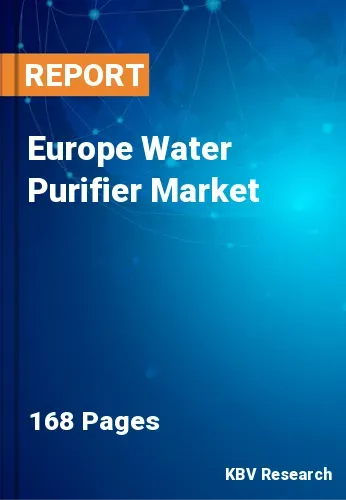The Europe Water Purifier Market would witness market growth of 9.0% CAGR during the forecast period (2023-2030). In the year 2020, the Europe market's volume surged to 18,671.2 thousand units, showcasing a growth of 8.8% (2019-2022).
Water purifiers serve various applications, catering to different needs and environments. They are utilized in various settings, including residential, commercial, industrial, and institutional spaces. In households, water purifiers are extensively used to ensure clean drinking water. They come in various forms, such as countertop filters, under-the-sink purifiers, pitcher filters, and point-of-entry purification systems. Commercial establishments, restaurants, hotels, and industries utilize more advanced and high-capacity purifiers to cater to larger water demands and ensure water quality for various purposes.
Moreover, water purifiers are also employed in institutions such as schools, hospitals, and public spaces to meet specific water quality standards and ensure the safety of water for consumption. Water purifiers are installed in schools and educational institutions to provide safe and clean drinking water for students and staff. This is vital for promoting a healthy environment, reducing the risk of waterborne diseases, and ensuring the well-being of children and young adults. Water purity is critical in healthcare settings to prevent infections and ensure patient safety. Hospitals utilize water purifiers to meet stringent standards for medical purposes, such as in laboratories, operation theaters, and patient care areas, where water quality is crucial for various procedures and patient health.
Rapid urbanization often leads to increased pollution, industrial activities, and a higher population density, which can affect the quality of municipal water supplies. Urban areas may face challenges in maintaining water quality standards. In cities like London, Paris, and Berlin, where industrial activities and population density are high, concerns about water quality have been raised. Water contamination or pollutants can lead residents to seek additional water purification measures. Therefore, growing urbanization in many European countries will boost the demand for water purifiers in the region.
The Germany market dominated the Europe Water Purifier Market, By Country in 2022, and would continue to be a dominant market till 2030; thereby, achieving a market value of $4,034.8 million by 2030. The UK market is exhibiting a CAGR of 8% during (2023 - 2030). Additionally, The France market would experience a CAGR of 9.8% during (2023 - 2030).
Based on Technology, the market is segmented into RO, UV, and Gravity Based. Based on End User, the market is segmented into Residential, and Commercial. Based on Portability, the market is segmented into Non-Portable, and Portable. Based on Distribution Channel, the market is segmented into Retail Stores, Direct Sales, and Online. Based on countries, the market is segmented into Germany, UK, France, Russia, Spain, Italy, and Rest of Europe.
Free Valuable Insights: The Global Water Purifier Market will Hit $76.2 Billion by 2030, at a CAGR of 9.5%
The market research report covers the analysis of key stakeholders of the market. Key companies profiled in the report include Pentair PLC, Kent Ro System Ltd., Panasonic Holdings Corporation, A. O. Smith Corporation, Unilever PLC, General Electric Company, Tata Chemicals Ltd., Brita Gmbh (Brita Group), Best Water Technology Group, LG Electronics, Inc. (LG Corporation).
By Technology (Volume, Thousand Units, USD Million, 2019-2030)
By End User (Volume, Thousand Units, USD Million, 2019-2030)
By Portability (Volume, Thousand Units, USD Million, 2019-2030)
By Distribution Channel (Volume, Thousand Units, USD Million, 2019-2030)
By Country (Volume, Thousand Units, USD Million, 2019-2030)

Our team of dedicated experts can provide you with attractive expansion opportunities for your business.

